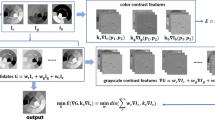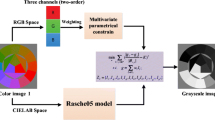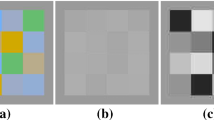Abstract
Converting color images into grayscale ones suffer from information loss. In the meantime, it is one fundamental tool indispensable for single channel image processing, digital printing, and monotone e-ink display. In this paper, we propose an optimization framework aiming at maximally preserving color contrast. Our main contribution is threefold. First, we employ a bimodal objective function to alleviate the restrictive order constraint for color mapping. Second, we develop an efficient solver that allows for automatic selection of suitable grayscales based on global contrast constraints. Third, we advocate a perceptual-based metric to measure contrast loss, as well as content preservation, in the produced grayscale images. It is among the first attempts in this field to quantitatively evaluate decolorization results.


















Similar content being viewed by others
Explore related subjects
Discover the latest articles, news and stories from top researchers in related subjects.Notes
It is suggested in Chen and Wang (2004) that \(\tau <6\) makes structures imperceivable to human visual system.
References
Achanta, R., Hemami, S. S., Estrada, F. J., & Susstrunk, S. (2009). Frequency-tuned salient region detection. In IEEE Conference on Computer Vision and Pattern Recognition (CVPR)
Ahn, J. H., Kuk, J. G., & Cho, N. I. (2010). A color to grayscale conversion considering local and global contrast. In Asian Conference on Computer Vision (ACCV).
Ancuti, C. O., Ancuti, C., & Bekaert, P. (2011). Enhancing by saliency-guided decolorization. In IEEE Conference on Computer Vision and Pattern Recognition (CVPR)
Bala, R., & Braun, K. (2004). Color-to-grayscale conversion to maintain discriminability. In Proceedings of SPIE, pp. 196–202.
Bala, R., & Eschbach, R. (2004). Spatial color-to-grayscale transform preserving chrominance edge information. In Color Imaging Conference.
Cadík, M. (2008). Perceptual evaluation of color-to-grayscale image conversions. Computer Graphics Forum, pp. 1745–1754.
Chen, H. C. & Wang, S. J. (2004). The use of visible color difference in the quantitative evaluation of color image segmentation. In International conference on acoustics, speech, and signal processing (ICASSP), vol. 3, pp. 593–596.
Corney, D., Haynes, J. D., Rees, G., & Lotto, R. B. (2009). The brightness of colour. PLoS ONE, 4(3), e5091.
Fairchild, M. D. (2005). Color appearance models. Chicheste: Wiley.
Gooch, Amy Ashurst, Olsen, Sven C., Tumblin, Jack, & Gooch, Bruce. (2005). Color2gray: Salience-preserving color removal. ACM Transactions on Graphics (TOG), 24(3), 634–639.
Grundland, Mark, & Dodgson, Neil A. (2007). Decolorize: Fast, contrast enhancing, color to grayscale conversion. Pattern Recognition, 40(11), 2891–2896.
Hunter, R. S. (1958). Photoelectric color difference meter. Journal of the Optical Society of America, 48(12), 985–993.
Kim, Y., Jang, C., Demouth, J., & Lee, S. (2009). Robust color-to-gray via nonlinear global mapping. ACM Transactions on Graphics (TOG), 28 (5)
Lotto, R. B., & Purves, D. (2002). A rationale for the structure of color space. Trends in Neurosciences, 25(2), 84–89.
Lu, C., Xu, L., & Jia, J. (2012). Contrast preserving decolorization. In International Conference on Computational Photography (ICCP).
Martin, D., Fowlkes, C., Tal, D., & Malik, J. (2001). A database of human segmented natural images and its application to evaluating segmentation algorithms and measuring ecological statistics. In International Conference on Computer Vision (ICCV).
Nayatani, Y. (1997). Simple estimation methods for the helmholtz kohlrausch effect. Color Research and Application, 24, 385–401.
Nelsen, R. B. (2001). Kendall tau metric. Berlin: Springer.
Neumann, L., Cadík, M., & Nemcsics, A. (2007). An efficient perception-based adaptive color to gray transformation. Computational Aesthetics
Ozgen, E. (2004). Language, learning, and color perception. Current Directions in Psychological Science, 13(3), 95–98.
Rasche, K., Geist, R., & Westall, J. (2005). Detail preserving reproduction of color images for monochromats and dichromats. IEEE Computer Graphics and Applications, pp. 22–30.
Reber, A. S. (1985). The Penguin dictionary of psychology. London: Penguin Books.
Sharma, G., & Bala, R. (2002). Digital Color Imaging Handbook. Boca Raton: CRC Press.
Smith, K., Landes, P. E., Thollot, J., & Myszkowski, K. (2008). Apparent greyscale: A simple and fast conversion to perceptually accurate images and video. Computer Graphics Forum, 27(2), 193–200.
Song, M., Tao, D., Chen, C., Li, X., & Chen, C. W. (2010). Color to gray: Visual cue preservation. IEEE Transactions on Pattern Analysis and Machine Intelligence (PAMI), 32(9), 1537–1552.
Wong, B. (2010). Points of view: Color coding. Nature Methods, 7(8), 573.
Wyszecki, G., & Stiles, W. S. (2000). Color science: Concepts and methods. Quantitative data and formulas. New York: Wiley-Interscience.
Zhou, K., Mo, L., Kay, P., Kwok, V., Ip, T. N., & Tan, L. H. (2010). Newly trained lexical categories produce lateralized categorical perception of color. In Proceedings of the National Academy of Sciences.
Acknowledgments
The authors would like to thank the editor and all the anonymous reviewers for their time and effort. This work is supported by a grant from the Research Grants Council of the Hong Kong SAR (Project No. 413110) and by NSF of China (key Project No. 61133009).
Author information
Authors and Affiliations
Corresponding author
Additional information
Communicated by Dr. Srinivas Narasimhan, Dr. Frédo Durand and Dr. Wolfgang Heidrich.
Electronic supplementary material
Below is the link to the electronic supplementary material.
Rights and permissions
About this article
Cite this article
Lu, C., Xu, L. & Jia, J. Contrast Preserving Decolorization with Perception-Based Quality Metrics. Int J Comput Vis 110, 222–239 (2014). https://doi.org/10.1007/s11263-014-0732-6
Received:
Accepted:
Published:
Issue Date:
DOI: https://doi.org/10.1007/s11263-014-0732-6




